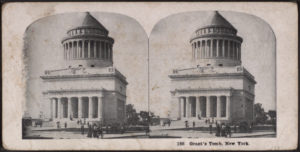Grant’s Tomb:
An Oral History at a Commemorative Landscape
By Sarah Dziedzic, 2009
Found in the Academic Commons
Read more about this project on the OHMA Blog
Grant‘s Tomb holds the bodies of Ulysses S. Grant and his wife, Julia Dent Grant. Built in 1897 in New York City‘s Riverside Park in Morningside Heights, the tomb and the surrounding plaza are officially the General Grant National Memorial, a name change that coincided with its establishment as a National Park Service site in 1959 after a long era of management by the Grant Monument Association. It is a historic monument and a site of public history; a New York City landmark and a place of national storytelling; a nineteenth century shrine and a complex memorial that also serves the present. In this work, I consider how Grant‘s Tomb becomes a place of diverse and personal meaning endowed with the ability to transport visitors to a past that reaches back to select points of the twentieth century, to the tomb‘s construction and Grant‘s death at the end of the nineteenth century, and to the American Civil War in the 1860s.
 Sarah Dziedzic works with the Felix Gonzalez-Torres Foundation developing an oral archive around the emergence and exhibition of Gonzalez-Torres’s artwork. She recently completed a project on the history of the Institute for Research on Women, Gender and Sexuality at the Columbia Center for Oral History Research, and is currently working on writing about the project for a number of publications. She is a graduate of Columbia’s Oral History Master of Arts program and serves on the Columbia Oral History Alumni Association Board of Directors. She also serves on the Board of Directors of Seven Stories Institute, which administers the volunteer-run Word Up Community Bookshop in Washington Heights as well as other programs that increase access to books in underserved communities. She has worked as an independent oral historian at Wave Hill Public Garden and Cultural Center, has also led numerous oral history workshops and discussions, and is co-founder of the Society for the Investigation of Place, which advocates for new methodologies for studying communities and landscape through creative collaboration.
Sarah Dziedzic works with the Felix Gonzalez-Torres Foundation developing an oral archive around the emergence and exhibition of Gonzalez-Torres’s artwork. She recently completed a project on the history of the Institute for Research on Women, Gender and Sexuality at the Columbia Center for Oral History Research, and is currently working on writing about the project for a number of publications. She is a graduate of Columbia’s Oral History Master of Arts program and serves on the Columbia Oral History Alumni Association Board of Directors. She also serves on the Board of Directors of Seven Stories Institute, which administers the volunteer-run Word Up Community Bookshop in Washington Heights as well as other programs that increase access to books in underserved communities. She has worked as an independent oral historian at Wave Hill Public Garden and Cultural Center, has also led numerous oral history workshops and discussions, and is co-founder of the Society for the Investigation of Place, which advocates for new methodologies for studying communities and landscape through creative collaboration.
